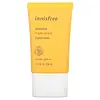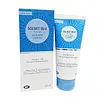What's inside
What's inside
 Key Ingredients
Key Ingredients

 Benefits
Benefits

 Concerns
Concerns

 Ingredients Side-by-side
Ingredients Side-by-side

Water
Skin ConditioningPropylheptyl Caprylate
EmollientTitanium Dioxide
Cosmetic ColorantZinc Oxide
Cosmetic ColorantCyclohexasiloxane
EmollientButylene Glycol Dicaprylate/Dicaprate
EmollientDisiloxane
Skin ConditioningButylene Glycol
HumectantPolyglyceryl-5 Polyricinoleate
EmulsifyingPolymethylsilsesquioxane
Glycerin
HumectantCaprylyl Methicone
Skin ConditioningDicaprylyl Ether
EmollientNiacinamide
SmoothingDisteardimonium Hectorite
StabilisingPolyglyceryl-3 Polydimethylsiloxyethyl Dimethicone
Skin ConditioningCalcium Aluminum Borosilicate
Magnesium Sulfate
1,2-Hexanediol
Skin ConditioningTriethoxycaprylylsilane
Octyldodecanol
EmollientParfum
MaskingDicaprylyl Carbonate
EmollientCI 77492
Cosmetic ColorantCaprylyl Glycol
EmollientGlyceryl Caprylate
EmollientMica
Cosmetic ColorantEthylhexylglycerin
Skin ConditioningAluminum Hydroxide
EmollientAdenosine
Skin ConditioningCI 77491
Cosmetic ColorantEchium Plantagineum Seed Oil
Skin ConditioningBoron Nitride
AbsorbentSodium Hyaluronate
HumectantPropylene Glycol Dicaprylate/Dicaprate
EmollientSaccharide Isomerate
HumectantPropanediol
SolventCI 77499
Cosmetic ColorantTocopherol
AntioxidantHelianthus Annuus Seed Oil Unsaponifiables
EmollientCardiospermum Halicacabum Flower/Leaf/Vine Extract
Skin ConditioningDimethicone/Vinyl Dimethicone Crosspolymer
Skin ConditioningOryza Sativa Bran Oil
EmollientLespedeza Capitata Leaf/Stem Extract
Skin ConditioningSodium Citrate
BufferingCitric Acid
BufferingWater, Propylheptyl Caprylate, Titanium Dioxide, Zinc Oxide, Cyclohexasiloxane, Butylene Glycol Dicaprylate/Dicaprate, Disiloxane, Butylene Glycol, Polyglyceryl-5 Polyricinoleate, Polymethylsilsesquioxane, Glycerin, Caprylyl Methicone, Dicaprylyl Ether, Niacinamide, Disteardimonium Hectorite, Polyglyceryl-3 Polydimethylsiloxyethyl Dimethicone, Calcium Aluminum Borosilicate, Magnesium Sulfate, 1,2-Hexanediol, Triethoxycaprylylsilane, Octyldodecanol, Parfum, Dicaprylyl Carbonate, CI 77492, Caprylyl Glycol, Glyceryl Caprylate, Mica, Ethylhexylglycerin, Aluminum Hydroxide, Adenosine, CI 77491, Echium Plantagineum Seed Oil, Boron Nitride, Sodium Hyaluronate, Propylene Glycol Dicaprylate/Dicaprate, Saccharide Isomerate, Propanediol, CI 77499, Tocopherol, Helianthus Annuus Seed Oil Unsaponifiables, Cardiospermum Halicacabum Flower/Leaf/Vine Extract, Dimethicone/Vinyl Dimethicone Crosspolymer, Oryza Sativa Bran Oil, Lespedeza Capitata Leaf/Stem Extract, Sodium Citrate, Citric Acid
Water
Skin ConditioningPhenylbenzimidazole Sulfonic Acid
UV AbsorberEthylhexyl Salicylate
UV AbsorberPropylene Glycol
HumectantAloe Barbadensis Leaf Extract
EmollientSolanum Lycopersicum Calyx Extract
Skin ConditioningCucumis Sativus Extract
Skin ConditioningCarbomer
Emulsion StabilisingTriethanolamine
BufferingMethylisothiazolinone
PreservativePolysorbate 20
EmulsifyingPEG-12 Dimethicone
Skin ConditioningAllantoin
Skin ConditioningParfum
MaskingDisodium EDTA
EDTA
CI 42090
Cosmetic ColorantWater, Phenylbenzimidazole Sulfonic Acid, Ethylhexyl Salicylate, Propylene Glycol, Aloe Barbadensis Leaf Extract, Solanum Lycopersicum Calyx Extract, Cucumis Sativus Extract, Carbomer, Triethanolamine, Methylisothiazolinone, Polysorbate 20, PEG-12 Dimethicone, Allantoin, Parfum, Disodium EDTA, EDTA, CI 42090
 Reviews
Reviews

Ingredients Explained
These ingredients are found in both products.
Ingredients higher up in an ingredient list are typically present in a larger amount.
Parfum is a catch-all term for an ingredient or more that is used to give a scent to products.
Also called "fragrance", this ingredient can be a blend of hundreds of chemicals or plant oils. This means every product with "fragrance" or "parfum" in the ingredients list is a different mixture.
For instance, Habanolide is a proprietary trade name for a specific aroma chemical. When used as a fragrance ingredient in cosmetics, most aroma chemicals fall under the broad labeling category of “FRAGRANCE” or “PARFUM” according to EU and US regulations.
The term 'parfum' or 'fragrance' is not regulated in many countries. In many cases, it is up to the brand to define this term.
For instance, many brands choose to label themselves as "fragrance-free" because they are not using synthetic fragrances. However, their products may still contain ingredients such as essential oils that are considered a fragrance by INCI standards.
One example is Calendula flower extract. Calendula is an essential oil that still imparts a scent or 'fragrance'.
Depending on the blend, the ingredients in the mixture can cause allergies and sensitivities on the skin. Some ingredients that are known EU allergens include linalool and citronellol.
Parfum can also be used to mask or cover an unpleasant scent.
The bottom line is: not all fragrances/parfum/ingredients are created equally. If you are worried about fragrances, we recommend taking a closer look at an ingredient. And of course, we always recommend speaking with a professional.
Learn more about ParfumWater. It's the most common cosmetic ingredient of all. You'll usually see it at the top of ingredient lists, meaning that it makes up the largest part of the product.
So why is it so popular? Water most often acts as a solvent - this means that it helps dissolve other ingredients into the formulation.
You'll also recognize water as that liquid we all need to stay alive. If you see this, drink a glass of water. Stay hydrated!
Learn more about Water